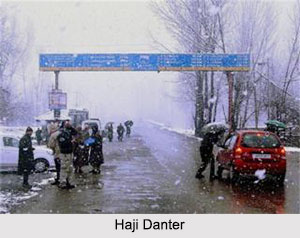 Haji Danter is the semi urban area in Anantnag in Anantnag district in Jammu Kashmir.
Haji Danter is the semi urban area in Anantnag in Anantnag district in Jammu Kashmir.
Location of Haji Danter
Haji Danter is adjacent to Anantnag town, just 2 kilometers away from Lalchowk Anantnag.
Visiting Information
The approaches to the village are through Achabal Adda, through Khanabal Chowk and through Naid Khunoo Harnaag.
Location of Haji Danter
Haji Danter is surrounded by all the three main rivers Anantnag & Brengi and the Aarpath and The Saandran.
Importance of Haji Danter
Haji Danter used to be main business hub in early times, because of water transport. The place has a port (place where ships board and deboard) in its surroundings called Ghaati pushwara.
Economy of Haji Danter
Haji Danter has the first automatic hydral grinding machine called Jindra, where people from far away places used to come and get their rice and spices ground.
Education of Haji Danter
Haji Danter has a population of around 1500 and has highest literacy rate among the areas surrounding it. The two main castes in this area are Malik and Bhat. Malik being dominant among the two. The people of this area are economically sound and the main occupation is Govt. Jobs and agriculture. The area being surrounded by rivers on all sides is frequently hit by floods.
Religion of Haji Danter
The main religion of the people is Islam and is very much liberal in nature.
Language of Haji Danter
Kashmiri language is the local language here. People also speak Urdu and Hindi. The place has population of about 1500 and has literacy rate of more than 85%.
Culture of Haji Danter
Hanji Danter is home to one of the respected Journalists and Author Rao Farman Ali Malik, who has floated first TV news channel of Kashmir, On The Track and has written more than 03 books on Kashmir conflict. The founder member of Jammu and Kashmir Alfatha movement Malik Mohammad Maqbool was also native of this village who was killed by Pro Pakistani Militants in 1992 leading to large scale protests. In modern times many scholars have abode in the place like Dr Hashim Iqbal Malik who is one of the prominent scholars of Kashmir.
Related Articles
Cities of Jammu and Kashmir
Culture of Jammu and Kashmir
Jammu and Kashmir, Indian State
Costumes of Jammu and Kashmir



















